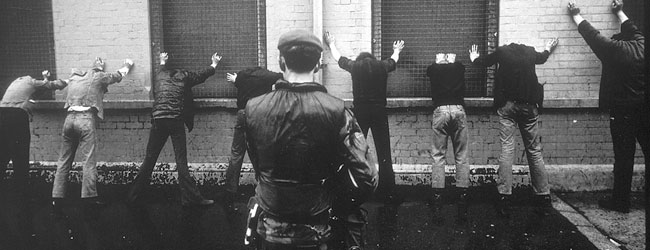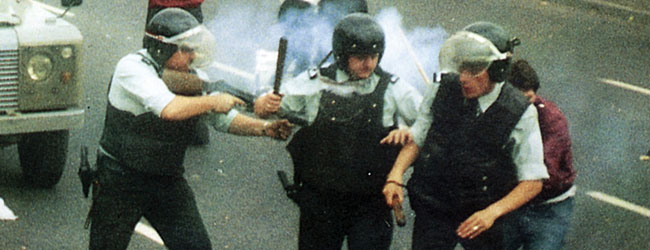30 July 2010
Remembering the Past BY MÍCHEÁL Mac DONNCHA
 Internment and resistance
Internment and resistance
NO single decision by the British Government in Ireland did more to violate human rights and to escalate the conflict than the decision to impose internment without trial in the Six Counties. Detention without charge was in force between August 1971 and December 1975 and during that time nearly 2,000 people were interned.
The significance of internment was somewhat over-shadowed in later years as people recalled the Bloody Sunday massacre in January 1972 and the long prison struggle and hunger strikes in the H-Blocks and Armagh Jail from 1976 to 1981. But the march which was attacked by the British Army in Derry on Bloody Sunday was an anti-internment demonstration and the H-Blocks/Armagh struggle arose from the criminalisation policy adopted by the British Government after internment failed to break republican resistance.
Internment, in fact, stoked the fires of resistance, filling the ranks of the IRA with young people from the beleaguered nationalist districts across the Six Counties and increasing support throughout Ireland. History was repeating itself as internment after the 1916 Rising and during the Tan War had a similar effect. And the internment of the 1970s was on the scale of that earlier era, rather than of the 1940s and 1950s when smaller numbers were interned.
Internment was imposed in the North between 1956 and 1961 by the unionist regime and the Minister for Home Affairs responsible for it from 1959 was Brian Faulkner. There were convulsions within the divided Unionist Party from 1968 onwards as they struggled to suppress the Civil Rights movement and in March 1971 Faulkner emerged as the new leader and prime minister. Believing that internment was the main factor in the failure of the IRA’s 1956-62 campaign, Faulkner was gung-ho for its reintroduction. In reality, the 1950s campaign had failed due to the IRA’s lack of active - as distinct from passive - political and military support in the Six Counties. The situation in 1971 was completely different.
The list of those targeted for internment was drawn up by the RUC and the British Army. It consisted mainly of people interned in the 1950s, known political activists of various political hues, and those whom the RUC and British Army believed to be IRA members. The list was wildly inaccurate and the combination of the haphazard targeting of people, basically because they were nationalists, and the brutal nature of its imposition, galvanised resistance to internment and proved to be a political disaster for the Stormont and British governments.
The blow fell in the early hours of Tuesday, August 9th 1971 when the British Army raided homes across the Six Counties:–
342 of the 450 men on the list were arrested;
116 were released within 48 hours;
226 were detained - 86 from Belfast, 60 from County Derry, 20 from Newry, 20 from Armagh and 40 from Tyrone and Fermanagh.
The raids were accompanied by widespread British Army brutality, assaults on people, wrecking of homes and many shootings. In Ballymurphy, the Parachute Regiment shot dead 11 innocent civilians in the three days after internment was imposed.
Addressing his “Catholic fellow-countrymen”, Faulkner said he was “now acting to remove the shadow of fear which hangs over too many of you”.
A number of those arrested in the initial and subsequent internment swoops were subjected to torture in interrogation centres in British Army barracks. Techniques included blindfolding and throwing from helicopters prisoners who believed they were hundreds of feet in the air, making prisoners run barefoot over broken glass, ‘white noise’ and other ‘sensory deprivation’ methods, forcing prisoners to stand for hours spreadeagled against a wall and straightforward beatings. The European Commission of Human Rights ruled in 1976 that the British authorities were guilty of torture and inhuman and degrading treatment.
A week after the initial swoop, Joe Cahill of the Belfast IRA appeared at a press conference in Belfast and revealed that fewer than 30 of those interned were Volunteers and that the IRA’s capacity to operate was undamaged.
A strong feature of the first six months of internment was the large number arrested and then released. Up to February 1972, over 2,300 were arrested under the Special Powers Act and 598 were interned. Arrest solely for the purpose of interrogation was widespread.
Internees were held initially in C-Wing of Crumlin Road Prison and on the Maidstone prison ship docked in Belfast harbour. But the main place of detention was to be an airfield just south of Lisburn used by the RAF during the Second World War and a British Army vehicle park since then. This was Long Kesh.
Long Kesh internment camp, by May 1972, consisted of ten ‘cages’. These were 12-foot-high wire fences topped with barbed wire and enclosing four Nissen huts and a washroom. Three huts were for sleeping and one for a canteen. There were 40 men to a hut in grossly over-crowded, poorly heated and unsanitary conditions.
A small number of women were interned in Armagh Prison, the first being Liz McKee, aged 19 who was interned on New Year’s Day 1973.
There were 1,981 people interned without trial in the Six Counties between August 9th 1971 and December 5th 1975, when internment was formally ended. Of this total, only 107 were loyalists.
Anniversary flashpoints

RUC fire plastic bullets at point-blank range during the internment anniversary rally in Belfast in 1984, killing John Downes
THE anniversary of internment was marked every year from August 1972 in nationalist districts.
In many places, bonfires were lit and in Belfast a national internment anniversary demonstration was held on the Sunday nearest August 9th until fairly recent years. This has been superseded by a number of highly-successful community festivals, including Féile an Phobail in west Belfast and Fleadh Ard Eoin in north Belfast, which are held at the time of the internment anniversary.
During the conflict, internment anniversaries were flashpoints of resistance. In 1977, the British Labour Government organised a ‘Jubilee’ visit by the Queen of England on August 10th, the day after the sixth anniversary of internment. The North was swamped with extra troops and hundreds of nationalists were arrested in raids in advance of the visit. Nevertheless, the IRA succeeded in planting a bomb in the New University of Ulster in Coleraine which exploded shortly after the queen left, while the internment anniversary was marked by a demonstration by thousands of people on the Falls Road behind a banner proclaiming ‘Elizabrit – Queen of Death’.
In 1984, the British Government banned Martin Galvin, of the US-based Irish Northern Aid, from entering the Six Counties. When he appeared on the platform at the annual Sinn Féin internment anniversary demonstration in Andersonstown, the crowd was attacked by the RUC firing plastic bullets and a young nationalist, John Downes, was killed by the RUC.
Follow us on Facebook
An Phoblacht on Twitter
Uncomfortable Conversations

An initiative for dialogue
for reconciliation
— — — — — — —
Contributions from key figures in the churches, academia and wider civic society as well as senior republican figures




